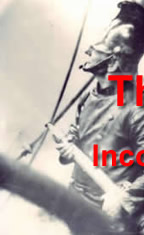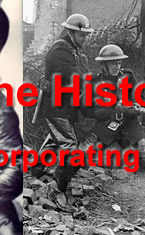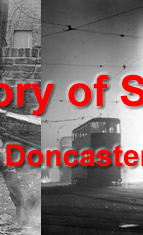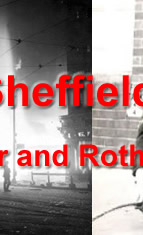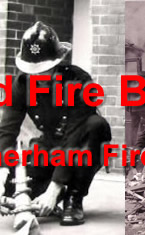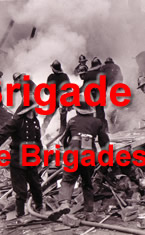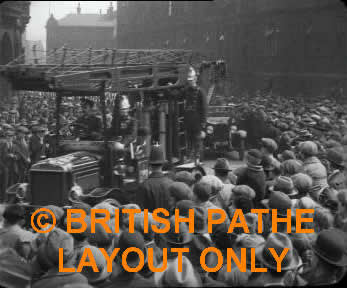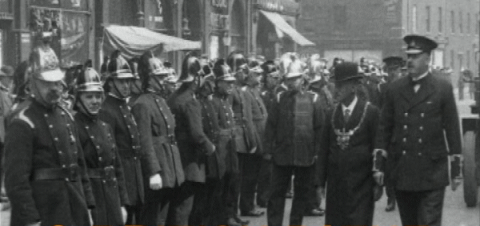
47 Year-old Frederick William Hadwick was born in 1869 at Sutherland Place, Brightside, Sheffield. His father, aged 52, was an Engineering Labourer, born in Barnsley, Yorkshire. His mother Charlotte was born in Louth, Lincolnshire. He had 5 brothers all who were born in Boston, Lincolnshire.
In 1881, 12 year-old Frederick was living with his family in Hexthorpe, Doncaster.
After leaving school he gained valuable engineering experience in the locomotive department of the Great Central Railway, in Doncaster. In 1891 he married Emma Guest at Fishlake, Nr Thorne, Yorkshire.
In 1894 he joined the Sheffield Police Force. Whilst serving in his probationary period a vacancy occurred for a Police/Fire Brigade Engineer, and because of his experience with railway locomotives he was appointed to the position.
In 1895 their son Arthur Edwin Hadwick was born at Rockingham Street Fire Station, Sheffield. The 1901 Census records show Frederick working as a Local Fire Brigade Engineer at Rockingham Street fire station.
Unfortunately, in June 1903 his wife Emma passed away.
On the 21st January 1905 Frederick re-married to Mary Lewis, aged 23, at Brimmington Parish Church.
In the 1911 Census Frederick was shown as having transferred to West Bar Fire Station and had risen to the rank of 2nd Officer. His wife Mary and his son Arthur were also shown as living at West Bar, and on the retirement of Superintendent William Frost in 1915, he was promoted to Chief Fire Officer.
Owing to the demands of the Great War the working strength of the Brigade had been gradually reduced because of the call on manpower for the fighting services, until at one time it was as low as three officers and twenty men. By 1916 the strength of the Brigade had become so depleted that a number of volunteer Firemen stood by at the two Fire Stations during the evening for the purpose of assisting the Brigade in both fire fighting and ambulance duties. The volunteer firemen were provided with an armband and training.
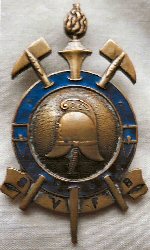 |
 Sheffield Volunteer Fire Brigade |
As a further consequence of this depletion and owing further to the possibility of fires being caused in Sheffield by bombs dropped by enemy aircraft all agreements for the attendance of the Brigade out of the City were cancelled and a notice to this effect was sent out on the 23rd February, 1916. It was agreed, however, that the hospitals at Wharncliffe, Longshaw Lodge and Dore would still be protected as long as they continued to be used as military hospitals.
| Zeppelin Raid
The only really damaging raid on Sheffield during the Great War came on September 25, 1916. The next day, The Star reported that 29 people had been killed when a Zeppelin airship bombed a North Midlands town. The North Midlands town was Sheffield but the paper wasn't allowed to say so. The report also mentioned that the principal attack was aimed against the industrial centres of this North Midlands town. That was Sheffield's East End, which escaped relatively unscathed. The Zeppelin dropped more than 30 bombs that night and among the dead were eight victims found in the cellar of a bombed house at Burngreave. Three fires were started by incendiary bombs dropped from German Zeppelins, two in dwelling houses and one in the Stores of the Great Central Railway at Woodbourn Road where a number of sleepers and timber were destroyed. |
          |
Photograph Courtesy of John Hague |
In November, 1918 the War to end wars was over. After the Armistice was signed, the Brigade gradually regained its normal strength, and on the 29th March, 1919, the volunteers at their own request were relieved from further service. The strength of the Brigade at this time was four Officers and 39 men.
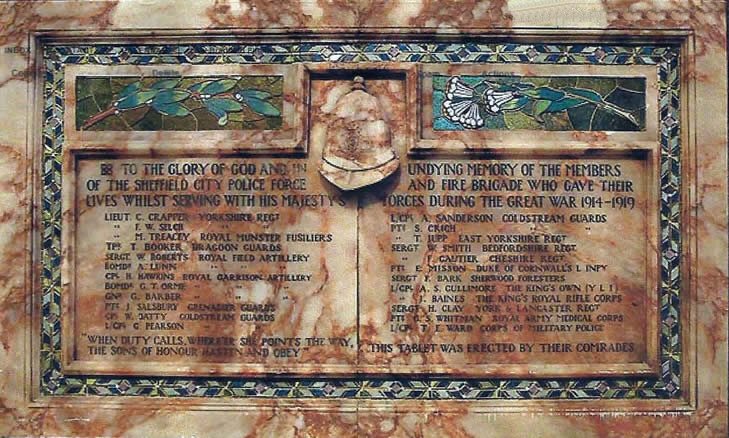 Photo by John Hague |
British Pathe Newsreel Clip
|
If you wish to download a short (5Mb) silent film of Superintendent Hadwick and the Lord Mayor inspecting Yorkshire's firemen at a conference in Sheffield on 11th May 1922. Go to British Pathe Downloads. and type the words 'Sheffield Firemen' into the 'Search Box', and select the file "Lord Mayor Inspects Firemen (AKA Yorkshire Firemen)".
|
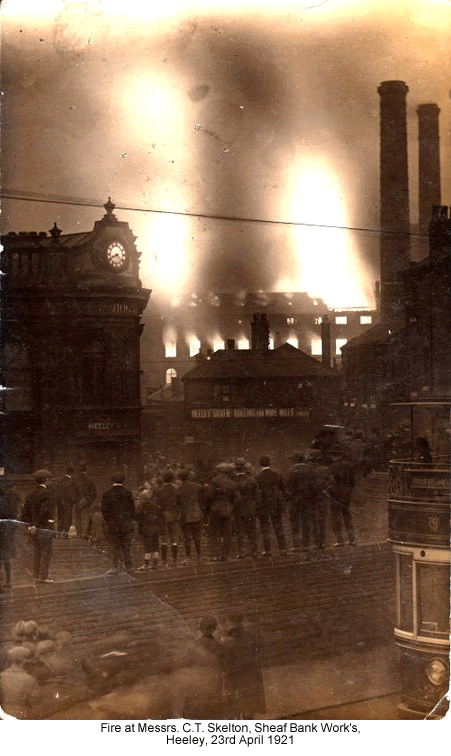 |
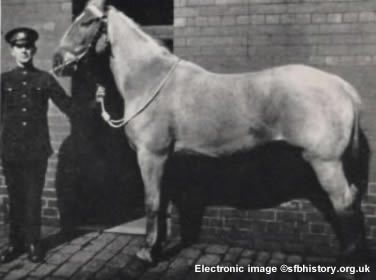 Photograph from: Sheffield Fire Brigade - A Brief History The horse "Gertie" which served with Sheffield Fire Brigade from 1912 to 1922 and was sold to the Mounted Police. |
Fire Chief to Retire
Sup. Hadwick’s Long Service with Sheffield Brigade
On 6th January 1923 it was reported that Superintendent. Frederick W. Hadwick, Chief Officer of the Fire Brigade, who is 53, years of age, and has completed 29 years’ approved service. Having given notice of his desire to retire from the Police Force was entitled to retire and to receive a pension for life of £353 6s 8d. per annum, and the Watch Committee approved of his leaving the force 31st January 1923.
It was resolved that the committee place on record their high appreciation of the services rendered to the city by Superintendent Hadwick during the many years he has occupied a responsible position in the brigade, including seven years as chief fire officer, and that a copy of this resolution, under the Corporate Common Seal, be presented to him.
Splendid Record
Superintendent Hadwick was appointed Chief Officer in January 1916, on the retirement of Mr William Frost. During the 13 years prior to that he had been Second Officer of the Brigade. He has been a popular chief with his men and retired with their best wishes.
He was a Sheffield man and spent most of his life in the city. At the commencement of his career he gained valuable engineering experience in the locomotive department of the Great Central Railway, first at Doncaster ant then later in Sheffield.
Whilst serving a probationary course in the Sheffield Police Force in 1894 vacancy occurred for an engineer, and he was appointed to the position. Five years’ later he received promotion and subsequently was placed in charge of West Bar station with the rank of Second Officer. Later he was transferred to Rockingham Street.
Superintendent Hadwick held three certificates presented by the Sheffield Watch Committee, for meritorious and efficient service, and the Long Service Medal of the Professional Fire Brigade Officers Association. He was also granted certificate by the Watch Committee in 1916 for stopping a runaway horse. He took a keen interest in the Sheffield Boy Scouts and the Boys Life Brigade.
Following his retirement Frederick moved to Lincolnshire, and made his home with Mary at 14 Station Road, Alford.
On 24th November 1951, Frederick passed away at the County Infirmary Louth Lincolnshire. According to the probate records he left £1497 5s 1d to his wife Mary.
